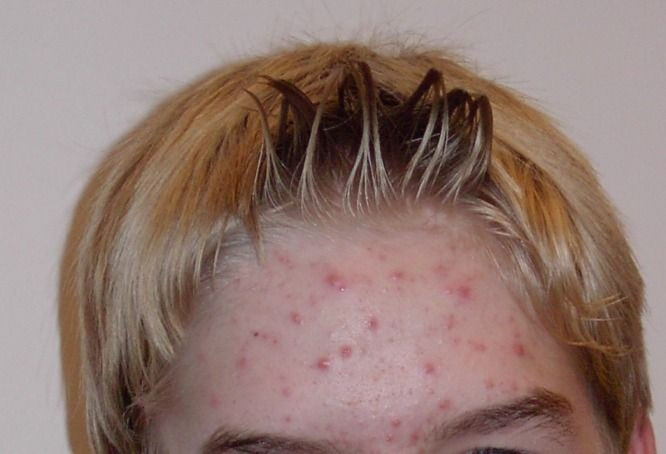Acne And Diet: Milk And High-Glycemic Foods May Exacerbate This Skin Condition

Our faces are our passports. As the most essential element of our appearance, our faces determine how readily others take to us as well as whether we are embraced, figuratively and literally, by others. A skin condition, such as acne, may be trivial on the physiological level, yet because it often affects and sometimes alters appearance, the impact on our lives may be subtle but also profound.
The American Academy of Dermatology ranks acne as the most common skin disorder in the U.S. Affecting 40 to 50 million Americans regardless of race or ethnicity, acne marks and often scars nearly 85 percent of people at some point in their lives. Although most who experience acne do so in puberty, adults also develop the skin condition, frequently on the face, chest, and back. In fact, about half of the women older than 24 have some facial acne, according to the Journal of American Academy of Dermatology.
In order to gain a wider understanding of the links between diet and acne, researchers at the University of Hull conducted a review of scientific literature on the topic.
Cause Or Contributing Factor?
No matter where it occurs — the face, neck, chest, back, shoulders, or upper arms — acne generally consists of pimples, cysts, blackheads, and whiteheads. When a pore in the skin becomes clogged with dead skin cells due to oil, a pimple is formed. The interplay of different components causes acne, such as the excessive production of oil by enlarged glands but also excessive division of skin cells. Meanwhile the growth of bacteria within the follicles causes an inflammatory response. In fact, acne vulgaris is considered a chronic inflammatory disease of the sebaceous follicles, which lie beneath the pores on the surface of the skin. The sebaceous gland secretes oil for the purpose of removing dead skin cells as well as to lubricate and even waterproof our outermost layer.
Although for many years dermatologists have discouraged the idea that diet may be responsible for acne, a relationship most certainly exists between food and skin condition or so the researchers at Hull unequivocally state. Although they have found no conclusive evidence within the scientific literature on the matter to prove that diet causes acne, they have determined that diets containing high-glycemic index foods, and milk in particular, appear to aggravate the condition.
"The research review suggests a low glycemic index diet but also a healthy diet, rich in fruit and vegetables, can have a protective effect on acne," said Dr. Katerina Steventon, from the University of Hull's Faculty of Health and Social Care.
Glycemic load is a measure of the effect of a certain food on blood glucose levels. High-glycemic load foods, including refined carbohydrates like pasta and fruits such as melon, produce a spike in blood glucose, spurring the production of excessive insulin. Such 'hyperinsulinemia' promotes inflammation and contributes to diabetes, heart disease, and several cancers.
Steventon is a Research Fellow with HONEI (Humber Obesity, Nutrition, Education and Innovation), which is comprised of world-class academics and clinicians from the Hull York Medical School (HYMS) and the University of Hull that focus on an examination of food and its relation to disease. HONEI has scheduled time later this year to conduct its own research to investigate the effects of certain foods on acne.
Relatedly, scientists at the University of Afyon Kocatepe in Turkey have found a relationship between the severity of acne and vitamins A and E as well as zinc.
Severity
In a study conducted at the University of Afyon Kocatepe in Turkey, the researchers focused on evaluating plasma levels of vitamin A, E, and zinc in relation to the seriousness of the skin disorder. Crucial to health, vitamins A and E are also basic antioxidants that are known to nourish the skin. Zinc, which plays a significant role in cellular metabolism, is another essential element and one that is required for both immune function and protein synthesis.
To accomplish their evaluation, the researchers worked with 94 acne patients and 56 age and sex matched healthy volunteers as a control group. After being categorized within the parameters of the Global Acne Grading System, the researchers separated the acne patients based on the severity of their symptoms and then further partitioned them into two groups, one containing the first two levels (mild to moderate acne), the other containing the last two levels (severe to very severe acne). Then, they assessed their plasma levels.
What did they find? As compared to the control group, plasma levels of vitamin E, vitamin A, and zinc were significantly lower in both groups of acne patients. When the two patient groups were compared, no statistically significant difference in plasma levels for vitamin A was found, but vitamin E and zinc levels were significantly lower in Group Two (severe cases) than in Group One. Given these results, the authors suggest that patients add foods rich in vitamins A and E as well as zinc to their diets for both treatment and prophylaxis of acne.
"Our study marks the importance of diet in patients with acne," wrote the authors. Clearly, in their exploration of the relationship between diet and acne, they will follow a similar journey to that of the researchers at HONEI.
Sources: Steventon K, Cowdell F. Acne and diet: a review of the latest evidence. Dermatological Nursing. 2013.
Ozuguz P, Dogruk Kacar S, Ekiz O, Takci Z, Balta I, Kalkan G. Evaluation of serum vitamins A and E and zinc levels according to the severity of acne vulgaris. Cutan Ocul Toxicol. 2013.



























